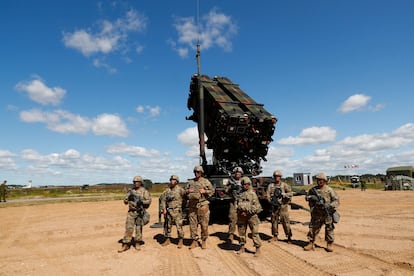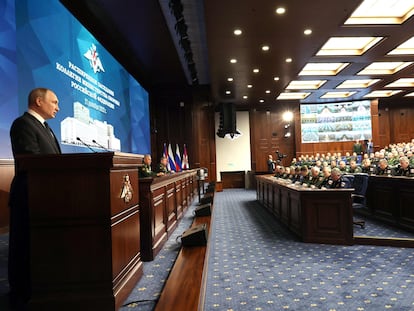US delivery of Patriot a symbolic and military boost for Ukraine’s air defenses
Moscow says Washington’s decision to provide the advanced missile system to Volodymyr Zelenskiy’s government is a ‘provocation’ and described them as ‘legitimate targets’


Damage from the last Russian attack, which took place just a week ago, are still visible on the roof of the gas station but the flicker of its neon lights stands out in the Kostiantynivka night. Little else is illuminated, other than a handful of houses and stores powered by generators. Inside, despite the gaping hole in the floor caused by a bombing raid, three women huddle in a corner to charge their cell phones and sip their machine cappuccinos. Like much of Ukraine, Kostiantynivka, in the Donetsk region around 12 miles from the front line and a town that has become a supply hub for the villages around it, has been left almost entirely devoid of power in the dead of winter after Russian strikes targeted its critical infrastructure.
Now, after months of asking for ways to “close the skies” over Ukraine against Russian air strikes, President Volodymyr Zelenskiy will return from his trip to Washington with a Patriot surface-to-air missile tactical defense system, one of the most advanced in the world and the US Army’s anti-ballistic missile system of choice.
The Patriot battery and its munitions differ from other hardware previously supplied to Ukraine in that it is capable of intercepting Russian ballistic missiles and reaching targets at a longer range than Kyiv previously was able to hit – between 25 and 100 miles, depending on the type of missile deployed – and is the most sophisticated armament the West has so far supplied to Ukraine. Patriot is “capable of bringing down cruise missiles, short-range ballistic missiles, and aircraft at a significantly higher ceiling than previously provided air defense systems,” a State Department spokesman was quoted by CNN as saying after the transfer was confirmed as part of a fresh Washington aid package for Kyiv that included mortars, additional ammunition for High Mobility Artillery Rocket System (HIMARS) systems, grenade launchers and small arms.
Moscow has described the US’ decision to provide Patriot to Kyiv as a “provocation” and warned that it considers them “legitimate targets” for air strikes. Patriot is already deployed by 18 countries worldwide, including several NATO members, Israel, Saudi Arabia, the UAE and Yemen. The provision of these systems, which are generally used to defend cities and critical infrastructure, had previously been a red line for the Joe Biden administration in its military support for Kyiv. And they do not come cheap: a single battery costs almost $1 billion and the missiles can cost several million dollars each – it is estimated that a single Patriot missile is three times more expensive than a surface-to-air missile used by the Norwegian NASAMS system, of which Ukraine has two.
However, Russia’s sustained air strikes on Ukrainian energy infrastructure over the past three months and Moscow’s growing alliance with Iran, which has provided Shahed attack drones – and increasing concern that Tehran may up its support for the Kremlin by sending ballistic missiles – caused the White House to reconsider its position.
The Patriot system will provide some relief to Ukraine’s beleaguered population, but not in the short-term. Kyiv has various different models of air defense systems in its armory but still lacks firepower in terms of anti-missile capabilities, according to Oleg Perlak, a senior Ukrainian Air Force commander. “Patriot systems are very effective in neutralizing virtually any missile threat, although in the current situation quantity is as important is quality. We need to close the skies and we need to do it now,” Perlak said.
According to Mark F. Cancian, a senior adviser with the Center for Strategic and International Studies Security Program, Patriot will not be an immediately decisive element in the war. A single battery with up to eight missile launchers, which is what Washington is intending to provide to Kyiv, will only serve to protect part of Ukraine and delivery is not expected before the spring. The US is expected to start training Ukrainian forces to use Patriot in Germany, according to Western intelligence sources.
Ukraine needs offensive weapons, long-range ammunition, armed drones, fighter jets and tanks, as its military leadership has stressed repeatedly. Zelenskiy’s administration and allies including Poland and the Baltic states have pushed for Washington to provide ATACMS long-range tactical missile systems and Gray Eagle armed drones, which so far the US has resisted. Kiev also requires more materiel to continue fighting Russian troops in Donbas and to launch another expected counter-offensive on the southern flank after successfully recapturing the port city of Kherson. Ukrainian intelligence has also warned of the specter of a fresh Russian offensive in early 2023, although Western intelligence agencies are not convinced it will materialize.
The delivery of Patriot also holds significant symbolic value for Kyiv, which views it as proof that Washington intends to remain firm in its commitment to maintaining military support to Ukraine for as long as necessary. The Biden administration’s latest aid package may also serve as a spur for other allies to follow the US lead and send more advanced and longer-range weapons, Western intelligence sources note. Kyiv currently has at its disposal two NASAMS systems, an S-300 air defense system provided by Slovakia and HAWK launcher systems sent by Spain.
Sign up for our weekly newsletter to get more English-language news coverage from EL PAÍS USA Edition
Tu suscripción se está usando en otro dispositivo
¿Quieres añadir otro usuario a tu suscripción?
Si continúas leyendo en este dispositivo, no se podrá leer en el otro.
FlechaTu suscripción se está usando en otro dispositivo y solo puedes acceder a EL PAÍS desde un dispositivo a la vez.
Si quieres compartir tu cuenta, cambia tu suscripción a la modalidad Premium, así podrás añadir otro usuario. Cada uno accederá con su propia cuenta de email, lo que os permitirá personalizar vuestra experiencia en EL PAÍS.
¿Tienes una suscripción de empresa? Accede aquí para contratar más cuentas.
En el caso de no saber quién está usando tu cuenta, te recomendamos cambiar tu contraseña aquí.
Si decides continuar compartiendo tu cuenta, este mensaje se mostrará en tu dispositivo y en el de la otra persona que está usando tu cuenta de forma indefinida, afectando a tu experiencia de lectura. Puedes consultar aquí los términos y condiciones de la suscripción digital.
More information
Archived In
Últimas noticias
There is as much life left to discover on planet Earth as that which is already known
Dozens presumed dead, around 100 injured in fire at Swiss Alps bar during New Year’s celebration
Is porn for women different from conventional porn? We spoke to those who make it
Cartagena de Indias is sinking: What can the city do to mitigate it?
Most viewed
- Sinaloa Cartel war is taking its toll on Los Chapitos
- Reinhard Genzel, Nobel laureate in physics: ‘One-minute videos will never give you the truth’
- Oona Chaplin: ‘I told James Cameron that I was living in a treehouse and starting a permaculture project with a friend’
- David King, chemist: ‘There are scientists studying how to cool the planet; nobody should stop these experiments from happening’
- Why the price of coffee has skyrocketed: from Brazilian plantations to specialty coffee houses










































